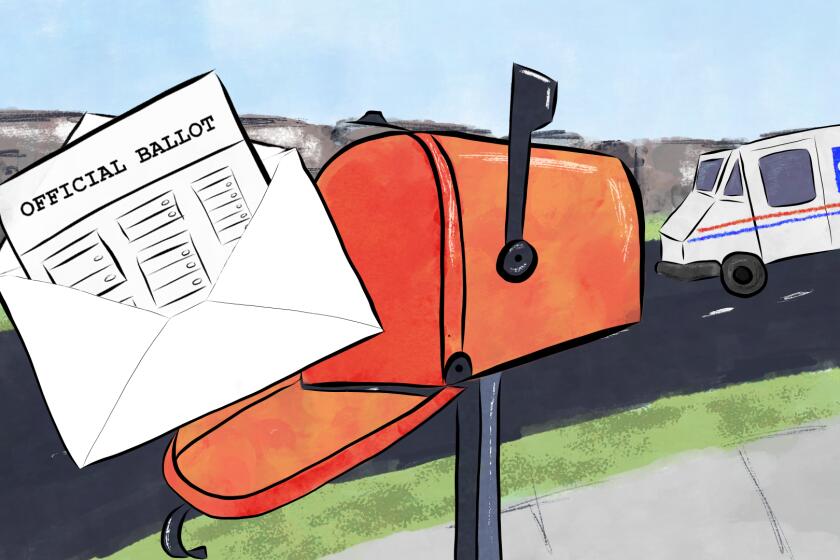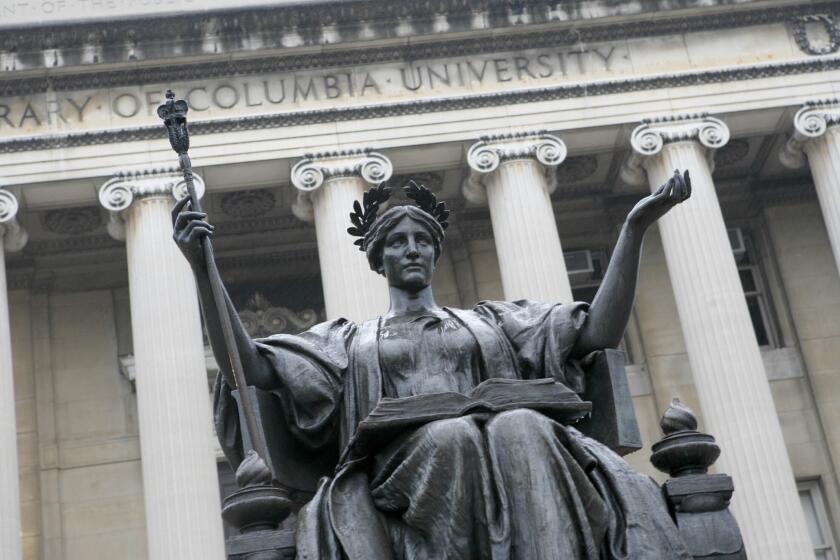Proposition 15 promises cash for schools and local governments. How much isn’t clear
There is little doubt that the passage of Proposition 15, which would levy new property taxes on high-value business property owners, would provide additional funds for K-12 schools and local governments across California.
The question for voters as election day approaches is how much money would be collected, especially during what could be a lingering pandemic-fueled recession, and whether a largely overlooked tax cut in the ballot measure might mean some communities across the state end up losing money.
Recent polls show voters remain sharply divided over the proposal, which would downsize the low-tax provisions of the landmark Proposition 13 by creating a new set of rules for taxing commercial and industrial properties. But supporters still outnumber opponents — 49% to 42% in a poll released Monday by UC Berkeley’s Institute of Governmental Studies — even though the number of undecided voters has declined as opposition has risen.
“Support for Prop. 15 continues to maintain a strong lead going into election day, and it reflects all polling to date showing that Californians support closing corporate tax loopholes to bring more investments into our local communities and schools,” said Alex Stack, a spokesman for the Yes on 15 campaign.
Any “loophole” that might exist is one that was put into law by voters. Proposition 13, which was approved by a wide margin in 1978, limits property taxes to 1% of the location’s assessed value and only small increases in that value until it’s sold. Supporters of Proposition 15 argue that voters four decades ago only meant to give homeowners, not large businesses, that kind of long-term tax break. And a series of studies through the years have concluded that some of California’s most successful corporations pay taxes on properties with land values dating back to the 1970s or earlier.
How much cash could Proposition 15 produce?
Although there’s been ample discussion of which businesses would feel the effects of higher taxes and the potential impact to the California economy, less emphasis has been placed on how the resulting tax revenues will be distributed.
Last fall, the independent Legislative Analyst’s Office estimated that Proposition 15 would generate $8 billion to $12.5 billion a year once it is fully implemented, which won’t be until 2025. The new commercial tax revenues would generally be spent in three ways: to cover costs of implementing Proposition 15, to K-12 schools and to local governments.
The first call on the money will be for reimbursements of start-up expenses. On the local level, Proposition 15 would require county tax assessors to devise a separate system for reviewing tens of thousands of business property values. An analysis commissioned by the California Assessors Assn., which opposes the ballot measure, concludes the new system would cost at least $380 million a year during the first five to 10 years of implementation.
The proposal also promises reimbursement for lost income tax revenue to the state. Because some property tax payments can be deducted from state taxes, the increase will result in an undetermined reduction in California general fund revenues.
Once those costs are covered, the Legislative Analyst’s Office projection assumes available new tax revenues ranging from $6.5 billion to $11.5 billion a year.
Tulare County Supervisor Kuyler Crocker said he thinks current economic conditions won’t produce revenues to that extent.
“I’ll believe it when I see it,” he said. “The timing’s awful.”
Money for schools doled out using state rules
The ballot measure, an amendment to the California Constitution, earmarks about 40% of the new commercial property tax revenues for K-12 schools and community colleges. The money would be in addition to existing education funds, supplementing a system that many supporters believe has been short on cash since Proposition 13 slashed property taxes four decades ago.
But Proposition 15 would create a unique, separate system for doling out the education dollars. Counties would transfer the new commercial property tax revenue to the California treasurer for deposit into a new state-managed fund. It would be an unusual arrangement, as all other property tax dollars spent on schools remain in the counties from which they are collected.
After sending 11% of the revenues to community colleges, state officials would hand out the remaining money to K-12 schools under a formula created by then-Gov. Jerry Brown and the Legislature in 2013, which sought to boost the success of students from low-income families, foster youth and children whose primary language isn’t English. The plan also removed a number of spending mandates issued to schools by the state over the years, known as “categoricals.” Although researchers concluded the effort championed by Brown did not meet all of its early expectations, it remains central to the state’s education goals.
Estimates by the California Teachers Assn., which supports the ballot measure, show Los Angeles Unified School District, the state’s largest system, could receive some $359 million a year in new funds under Proposition 15. The 10 largest districts would receive a total of more than $726 million, according to the group’s estimate. But those projections were made before the pandemic, which means the underlying economic assumptions may no longer be valid.
Even then, the opposition campaign funded by California’s largest businesses argues school districts are likely to use the money to offset a number of existing expenses, including employee pension obligations.
“I think there’s a general distrust,” said Michael Bustamante, a spokesman for the No on 15 campaign. “Folks have grown weary of all these promises that are going to fix education.”
Not all local communities will be treated the same
Proposition 15 revenues for schools would be distributed through a new method, but the rest of the boost in commercial property taxes — close to 60% — would be divided among local governments under a formula first put in place in 1979.
Those rules have been the subject of frequent debate in Sacramento ever since. In some ways, the percentages of property tax revenues given to a county, its various cities and special districts are still based on how the money was distributed before Proposition 13 passed in 1978. That template remains unchanged if voters approve Proposition 15.
As a result, the money won’t be distributed equally on a per capita basis. Data provided by the campaign in support of the ballot measure show government services in Riverside County, for example, will receive less than those in Santa Clara or Alameda counties, even though Riverside has a larger population. Ventura County, with an estimated population slightly smaller than that of San Francisco, could receive $272 million a year less from Proposition 15.
That data covers only 28 counties in California. Proposition 15 supporters don’t have any estimates for the tax benefits in 30 other counties, largely those spread out across the most rural regions in the state. And critics said they worry that local services in some of those communities will see less — not more — tax revenue under the proposal.
A business tax cut in Prop. 15 could cost rural regions
“There are going to be counties within our group that are going to lose out,” said Paul Smith, senior vice president for government affairs of the Rural County Representatives of California. “It’s not going to be a winner for everyone.”
Smith’s organization chose to oppose Proposition 15 primarily because it includes a little-discussed tax cut for businesses, resulting in a loss of local tax revenue that may not be noticed in California’s urban centers.
The ballot measure would eliminate the tangible personal property tax on equipment and fixtures for small businesses and provide an annual $500,000 equipment exemption for all other businesses. The tax break would begin in 2024 and could not be rescinded by the Legislature.
Large communities, home to the high-value business properties that would see their assessed values rise under Proposition 15, would almost surely receive more in new revenue than they lose under the new tax incentive. But in rural communities, there are few or none of the commercial and industrial properties that would pay higher taxes.
Stack, the Yes on 15 campaign spokesman, said the supporters’ analysis sees an overall boost for both the state’s large and far-flung communities.
“Small businesses in every single county will benefit from the tax relief included in Prop. 15,” he said. “For a few of the least populated and most remote counties in California, schools will overwhelmingly benefit while some local governments would break even.”
Smith said he’s not so sure about that, noting that services such as law enforcement and fire protection are provided by counties and special districts that rely heavily on the business equipment provisions under current property tax rules.
“The tax break may help the business in Ventura or the restaurant in East L.A.,” he said. “But this is the disconnect between rural California and the rest of the state.”
More to Read
Start your day right
Sign up for Essential California for news, features and recommendations from the L.A. Times and beyond in your inbox six days a week.
You may occasionally receive promotional content from the Los Angeles Times.








